Inhalants: Just a phase?
What Are Inhalants?
Inhalants are volatile substances that produce chemical vapors that can be inhaled to induce a psychoactive, or mind-altering, effect. Although other abused substances can be inhaled, the term "inhalants" is used to describe a variety of substances whose main common characteristic is that they are rarely, if ever, taken by any route other than inhalation. This definition encompasses a broad range of chemicals that may have different pharmacological effects and are found in hundreds of different products. As a result, precise categorization of inhalants is difficult. One classification system lists four general categories of inhalants—volatile solvents, aerosols, gases, and nitrites—based on the forms in which they are often found in household, industrial, and medical products. ( NIDA Research Report Series: Inhalant Abuse)
Inhalants aren't really that dangerous are they?
A. BRAIN The chemicals abused by inhalant users affect different parts of the brain, producing a variety of sensory and psychological disorders. Many inhalants are thought to dissolve the protective myelin sheath that surrounds neurons - brain cells - resulting in cell death (see brain diagram).
B. CEREBRAL CORTEX Cellular death here causes permanent personality changes, memory impairment, hallucinations and learning disabilities.
C. CEREBELLUM This is the center that controls balance and coordination. Inhalant-related damage results in loss of coordination and slurred speech. Chronic abusers experience tremors and uncontrollable shaking.
D. OPHTHALMIC NERVE Toluene may affect this nerve causing sight disorders.
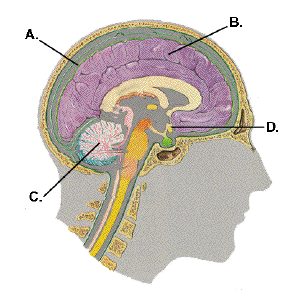
A. BLOOD Some substances like nitrites and methylene chloride (paint thinner) chemically block the oxygen carrying capacity of the blood. |
B. LUNGS Repeated use of spray paint as an inhalant can cause lung damage. |
C. HEART Abuse of inhalants can result in "sudden sniffing death syndrome." This is due to a sudden and unexpected disturbance of the heart's rhythm. All inhalants can produce sudden sniffing death syndrome. |
D. LIVER Halogenated compounds like trichloroethylene (a component of aerosol paints and correction fluid) have been linked to damage of this organ. |
E. KIDNEY Inhalants containing toluene impair the kidney's ability to control the amount of acid in the blood. This is reversible when toluene leaves the body but, in the long-term, kidney stones may develop. |
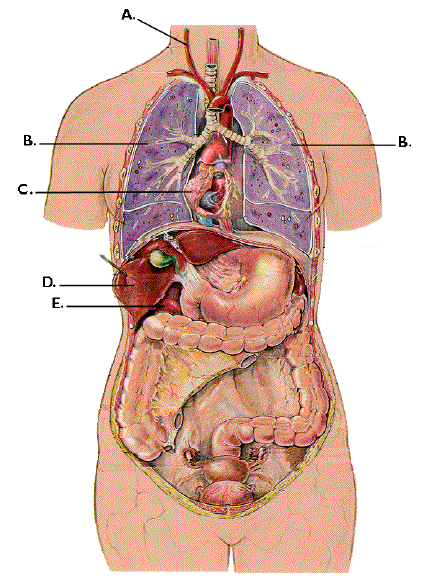
A. MUSCLE Chronic inhalant abuse can lead to muscle wasting, reduced muscle tone and strength. |
B. BONE MARROW Benzene, a component of gasoline, has been shown to cause leukemia. |
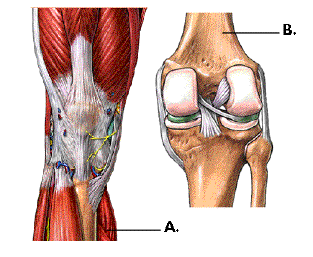
ADDITIONAL DAMAGE CAUSED BY INHALANTS
PERIPHERAL NERVOUS SYSTEM Chronic inhalation of nitrous oxide (whipped cream propellant) and hexane (found in some glues and camp stove fuels) results in damage to the peripheral nerves. Symptoms can include numbness, a tingling sensation or total paralysis.
ACOUSTIC NERVE AND MUSCLE Toluene inhalation destroys cells that relay sound to the brain. Chronic abusers can become deaf.
Types of Inhalants
Most abused inhalants are found in perfectly legal products, many of which are readily available in the average household. Abused inhalants can be broadly divided into four categories: volatile solvents, gases, nitrates and aerosols. Each of these categories affect the central nervous system:
Type |
Source |
Examples |
Volatile Solvents |
any liquid that vaporizes at room temperature |
- correcting fluid
- degreasers
- dry cleaning fluid
- felt tip markers
- gasoline
- glue
- paint remover
- paint thinner.
|
Aerosols |
sprays containing propellants |
- deodorant
- fabric protector spray
- hair spray
- spray paint
- vegetable oil cooking spray.
|
Gases |
medical, industrial and household products |
- ether
- chloroform
- halothane
- nitrous oxide
- butane (lighters)
- propane
- whipping cream containers that contain nitrous oxide.
|
Most inhalants cause intoxication and euphoria. Nitrates are a noticeable exception. Mostly abused by older teens and young adults, nitrates are used in the belief that the inhalants heighten sexual function and sensation. Nitrates include the following inhalants:
- cyclohexyl nitrate (found in room deodorizers)
- isoamyl/amyl nitrate (prescribed for heart pain)
- butyl nitrate (an illegal street drug).
Both amyl nitrate and butyl nitrate are often sold on the street in small bottles, and are referred to as poppers.
Huffing and Other Inhalant Use
Huffing is only one method of inhalant use. When huffing, inhalant abusers soak a rag with the inhalant and stuff the rag in their mouths. The inhalant is then inspirated rapidly and repeatedly, hence the term huffing.
Other methods of inhalant use include sniffing or snorting the inhalants directly from a container, or spraying aerosols directly into the mouth. Balloons can be filled with gas and inhaled as the balloon deflates. This is a common method for inhaling nitrous oxide.
"Bagging" refers to inhaling from a plastic bag into which the inhalant has been emptied or sprayed.
No matter which method is used to inhale these toxic substances, abusing inhalants is always dangerous.
How Inhalants Act on the Brain
All inhalants are absorbed through the lungs and spread throughout the body and brain within minutes. With the exception of nitrates, inhalant use produces an effect similar to alcohol intoxication. The inhalant user may have slurred speech, experience euphoria and act dizzy or drunk. Intoxication from inhalant use lasts only a few minutes.
To prolong intoxication, users often engage in repetitive huffing. This is a particularly dangerous practice that can be fatal.
Sudden Sniffing Death and Inhalant Use
One of the most serious health complications associated with inhalant use is sudden sniffing death. Huffing or sniffing inhalants for long periods slowly fills the lungs with the inhalants and prevents the inhalant user from getting sufficient oxygen in the lungs. This results in the sudden onset of heart irregularities, which quickly worsen into heart failure.
Death from sudden sniffing death occurs within minutes. The condition is not confined to chronic inhalant users. People trying huffing or inhalant use for the first time are just as susceptible to sudden sniffing death as are long-term abusers.
Inhalant Use Health Risks
Long-term inhalant use can produce strong cravings and compulsive huffing. Withdrawal symptoms may develop when inhalant use is interrupted.
Other health concerns associated with long-term huffing and inhalant use include:
- apathy and stupor
- attention problems
- brain and nervous system damage
- confusion
- damage to the heart, lungs, liver and kidneys
- death by choking (from inhaling vomit)
- death by suffocation (from bagging or huffing)
- delirium
- dementia
- depression
- fatal accidents
- fetal developmental problems if the inhalant user is pregnant
- hearing and vision problems
- impaired cognitive function
- impaired judgment
- loss of coordination
- muscle weakness
- nausea and vomiting
- spasticity
- weight loss.
Inhalant Use Warning Signs
Educating children about the dangers of inhalant use and clear parental disapproval of such acts remain the best methods for preventing huffing. However, inhalant use can affect any family, so parents should learn to identify signs of huffing and other inhalant use.
Warning signs include:
- apparent drunkenness
- chemical odors from breath, clothing or child's room
- clothes soaked with chemicals
- hidden empty spray paint or solvent containers
- hidden rags soaked with chemicals
- irritability, social withdrawal and depression
- loss of appetite
- nausea and vomiting
- paint stains on the hands, face and clothes
- red or runny nose
- sores and rashes around the mouth and nose.
Street Slang Concerning Inhalant Use and Huffing
These are common terms for abused inhalants:
- amys
- boppers
- climax
- gluey
- hardware
- head cleaner
- locker room
- moon gas
- poor man's pot
- poppers
- snappers.
|
What Types of Products Are Abused as Inhalants?
Inhalants generally fall into the following categories:
Volatile solvents—liquids that vaporize at room temperature
- Industrial or household products, including paint thinners or removers, degreasers, dry-cleaning fluids, gasoline, and lighter fluid
- Art or office supply solvents, including correction fluids, felt-tip marker fluid, electronic contact cleaners, and glue
Aerosols—sprays that contain propellants and solvents
- Household aerosol propellants in items such as spray paints, hair or deodorant sprays, fabric protector sprays, aerosol computer cleaning products, and vegetable oil sprays
Gases—found in household or commercial products and used as medical anesthetics
- Household or commercial products, including butane lighters and propane tanks, whipped cream aerosols or dispensers (whippets), and refrigerant gases
- Medical anesthetics, such as ether, chloroform, halothane, and nitrous oxide (“laughing gas”)
Nitrites—a special class of inhalants that are used primarily as sexual enhancers
- Organic nitrites are volatiles that include cyclohexyl, butyl, and amyl nitrites, commonly known as “poppers.” Amyl nitrite is still used in certain diagnostic medical procedures. When marketed for illicit use, organic nitrites are often sold in small brown bottles labeled as “video head cleaner,” “room odorizer,” “leather cleaner,” or “liquid aroma.”
These various products contain a wide range of chemicals such as—
- toluene (spray paints, rubber cement, gasoline),
- chlorinated hydrocarbons (dry-cleaning chemicals, correction fluids),
- hexane (glues, gasoline),
- benzene (gasoline),
- methylene chloride (varnish removers, paint thinners),
- butane (cigarette lighter refills, air fresheners), and
- nitrous oxide (whipped cream dispensers, gas cylinders).
Adolescents tend to abuse different products at different ages.2 Among new users ages 12–15, the most commonly abused inhalants are glue, shoe polish, spray paints, gasoline, and lighter fluid. Among new users age 16 or 17, the most commonly abused products are nitrous oxide or whippets. Nitrites are the class of inhalants most commonly abused by adults.3
How Are Inhalants Abused?
Inhalants can be breathed in through the nose or mouth in a variety of ways (known as “huffing”), such as sniffing or snorting fumes from a container, spraying aerosols directly into the nose or mouth, or placing an inhalant-soaked rag in the mouth. Users may also inhale fumes from a balloon or a plastic or paper bag that contains an inhalant.The intoxication produced by inhalants usually lasts just a few minutes; therefore, users often try to extend the “high” by continuing to inhale repeatedly over several hours.
How Do Inhalants Affect the Brain?
The effects of inhalants are similar to those of alcohol, including slurred speech, lack of coordination, euphoria, and dizziness. Inhalant abusers may also experience lightheadedness, hallucinations, and delusions. With repeated inhalations, many users feel less inhibited and less in control. Some may feel drowsy for several hours and experience a lingering headache. Chemicals found in different types of inhaled products may produce a variety of additional effects, such as confusion, nausea, or vomiting.
By displacing air in the lungs, inhalants deprive the body of oxygen, a condition known as hypoxia. Hypoxia can damage cells throughout the body, but the cells of the brain are especially sensitive to it. The symptoms of brain hypoxia vary according to which regions of the brain are affected: for example, the hippocampus helps control memory, so someone who repeatedly uses inhalants may lose the ability to learn new things or may have a hard time carrying on simple conversations.
Long-term inhalant abuse can also break down myelin, a fatty tissue that surrounds and protects some nerve fibers. Myelin helps nerve fibers carry their messages quickly and efficiently, and when damaged, can lead to muscle spasms and tremors or even permanent difficulty with basic actions such as walking, bending, and talking.
Although not very common, addiction to inhalants can occur with repeated abuse. According to the 2006 Treatment Episode Data Set, inhalants were reported as the primary substance abused by less than 0.1 percent of all individuals admitted to substance abuse treatment.4 However, of those individuals who reported inhalants as their primary, secondary, or tertiary drug of abuse, nearly half were adolescents aged 12 to 17. This age group represents only 8 percent of total admissions to treatment.5
What Other Adverse Effects Do Inhalants Have on Health?
Lethal Effects
Sniffing highly concentrated amounts of the chemicals in solvents or aerosol sprays can directly induce heart failure and death within minutes of a session of repeated inhalation. This syndrome, known as “sudden sniffing death,” can result from a single session of inhalant use by an otherwise healthy young person. Sudden sniffing death is particularly associated with the abuse of butane, propane, and chemicals in aerosols.
High concentrations of inhalants may also cause death from suffocation by displacing oxygen in the lungs, causing the user to lose consciousness and stop breathing. Deliberately inhaling from a paper or plastic bag or in a closed area greatly increases the chances of suffocation. Even when using aerosols or volatile products for their legitimate purposes (i.e., painting, cleaning), it is wise to do so in a well-ventilated room or outdoors.
Harmful Irreversible Effects
- Hearing loss—spray paints, glues, dewaxers, dry-cleaning chemicals, correction fluids
- Peripheral neuropathies or limb spasms—glues, gasoline, whipped cream dispensers, gas cylinders
- Central nervous system or brain damage—spray paints, glues, dewaxers
- Bone marrow damage—gasoline
Serious but Potentially Reversible Effects
- Liver and kidney damage—correction fluids, dry-cleaning fluids
- Blood oxygen depletion—varnish removers, paint thinners
HIV/AIDS, Hepatitis, and Other Infectious Diseases
Because nitrites are abused to enhance sexual pleasure and performance, they can be associated with unsafe sexual practices that greatly increase the risk of contracting and spreading infectious diseases such as HIV/AIDS and hepatitis.
How Widespread Is Inhalant Abuse?
Monitoring the Future Survey*
According to the Monitoring the Future survey, more 8th-graders (15.7 percent) have tried inhalants in their lifetime than any other illicit drug, including marijuana. Lifetime use (use at least once during a respondent’s lifetime) of inhalants was reported by 15.7 percent of 8th-graders, 12.8 percent of 10th-graders, and 9.9 percent of 12th-graders in 2008; 4.1 percent of 8th-graders, 2.1 percent of 10th-graders, and 1.4 percent of 12th-graders were current users of inhalants (had used at least once during the 30 days preceding response to the survey).
The perception of harm associated with trying inhalants once or twice is at its lowest level among 8th-graders—in 2008, 34 percent of 8th-graders perceived harm, compared to 46 percent in 2001. This change in attitude could signal a subsequent increase in use, an outcome that would be of great concern.
National Survey on Drug Use and Health (NSDUH)**
Data from the National Survey on Drug Use and Health show that the primary abusers of most inhalants are adolescents ages 12 to 17. In 2007, 3.9 percent of adolescents reported using inhalants in the past year. Among young adults aged 18 to 25, past-year use of inhalants decreased from 1.8 percent in 2006 to 1.6 percent in 2007. Of the 775,000 persons aged 12 or older who tried inhalants for the first time within the previous year, 66.3 percent were under age 18 when they first used.

What Are Inhalants?
Inhalants are volatile substances that produce chemical vapors that can be inhaled to induce a psychoactive, or mind-altering, effect. Although other abused substances can be inhaled, the term "inhalants" is used to describe a variety of substances whose main common characteristic is that they are rarely, if ever, taken by any route other than inhalation. This definition encompasses a broad range of chemicals that may have different pharmacological effects and are found in hundreds of different products. As a result, precise categorization of inhalants is difficult. One classification system lists four general categories of inhalants—volatile solvents, aerosols, gases, and nitrites—based on the forms in which they are often found in household, industrial, and medical products. ( NIDA Research Report Series: Inhalant Abuse)
Although many parents are appropriately concerned about illicit drugs such as marijuana, cocaine, and LSD, they often ignore the dangers posed to their children from common household products that contain volatile solvents or aerosols. Products such as glues, nail polish remover, lighter fluid, spray paints, deodorant and hair sprays, whipped cream canisters, and cleaning fluids are widely available yet far from innocuous. Many young people inhale the vapors from these sources in search of quick intoxication without being aware that using inhalants, even once, can have serious health consequences.
National surveys indicate that nearly 22.3 million Americans have used inhalants at least once in their lives. NIDA's Monitoring the Future study reveals that 15.7 percent of eighthgraders have ever used inhalants. Parents and children need to know that even sporadic or single episodes of inhalant abuse can be extremely dangerous. Inhalants can disrupt heart rhythms and cause death from cardiac arrest, or lower oxygen levels enough to cause suffocation. Regular abuse of these substances can result in serious harm to vital organs, including the brain, heart, kidneys, and liver.
Through scientific research, we have learned much about the nature and extent of inhalant abuse, its pharmacology, and its consequences. This research has brought the picture of inhalant abuse in the Nation into focus and pointed to the dangers and the warning signs for parents, educators, and clinicians. We hope this compilation of the latest scientific information will help alert readers to inhalant abuse and its harmful effects and aid efforts to deal with this problem effectively.
How Are Inhalants Used?

Most inhalants produce a rapid high that resembles alcohol intoxication, with initial excitation then drowsiness, disinhibition, lightheadedness, and agitation.
Inhalants can be breathed in through the nose or the mouth in a variety of ways, such as—
- "sniffing" or "snorting" fumes from containers;
- spraying aerosols directly into the nose or mouth;
- "bagging"—sniffing or inhaling fumes from substances sprayed or deposited inside a plastic or paper bag;
- "huffing" from an inhalantsoaked rag stuffed in the mouth; and
- inhaling from balloons filled with nitrous oxide.
Inhaled chemicals are absorbed rapidly into the bloodstream through the lungs and quickly distributed to the brain and other organs. Within seconds of inhalation, the user experiences intoxication along with other effects similar to those produced by alcohol. Alcohol-like effects may include slurred speech; inability to coordinate movements; euphoria; and dizziness. In addition, users may experience lightheadedness, hallucinations, and delusions.
Because intoxication lasts only a few minutes, abusers frequently seek to prolong the high by continuing to inhale repeatedly over the course of several hours, a very dangerous practice. With successive inhalations, abusers can suffer loss of consciousness and possibly even death. At the least, they will feel less inhibited and less in control. After heavy use of inhalants, abusers may feel drowsy for several hours and experience a lingering headache.
What Are the Short- and Long- Term Effects of Inhalant Use?
Although the chemical substances found in inhalants may produce various pharmacological effects, most inhalants produce a rapid high that resembles alcohol intoxication, with initial excitation then drowsiness, disinhibition, lightheadedness, and agitation. If sufficient amounts are inhaled, nearly all solvents and gases produce anesthesia—a loss of sensation—and even unconsciousness.

The chemicals found in solvents, aerosol sprays, and gases can produce a variety of additional effects during or shortly after use. These effects are related to inhalant intoxication and may include belligerence, apathy, impaired judgment, and impaired functioning in work or social situations; nausea and vomiting are other common side effects. Exposure to high doses can cause confusion and delirium. In addition, other possible effects include dizziness, drowsiness, slurred speech, lethargy, depressed reflexes, general muscle weakness, and stupor. For example, research shows that toluene can produce headache, euphoria, giddy feelings, and inability to coordinate movements.
Inhaled nitrites dilate blood vessels, increase heart rate, and produce a sensation of heat and excitement that can last for several minutes. Other effects can include flush, dizziness, and headache.
A strong need to continue using inhalants has been reported by many individuals, particularly those who have abused inhalants for prolonged periods over many days. Compulsive use and a mild withdrawal syndrome can occur with long-term inhalant abuse. A recent survey of 43,000 American adults suggests that inhalant users, on average, initiate use of cigarettes, alcohol, and almost all other drugs at younger ages and display a higher lifetime prevalence of substance use disorders, including abuse of prescription drugs, when compared with substance abusers without a history of inhalant use.
What Are the Other Medical Consequences of Inhalant Abuse?
Inhalant abusers risk an array of other devastating medical consequences. The highly concentrated chemicals in solvents or aerosol sprays can induce irregular and rapid heart rhythms and lead to a fatal heart failure within minutes of a session of prolonged sniffing. This syndrome, known as "sudden sniffing death," can result from a single session of inhalant use by an otherwise healthy young person. Sudden sniffing death is associated particularly with the abuse of butane, propane, and chemicals in aerosols. Inhalant abuse also can cause death by—
- asphyxiation—from repeated inhalations, which lead to high concentrations of inhaled fumes displacing the available oxygen in the lungs;
- suffocation—from blocking air from entering the lungs when inhaling fumes from a plastic bag placed over the head;
- convulsions or seizures—from abnormal electrical discharges in the brain;
- coma—from the brain shutting down all but the most vital functions;
- choking—from inhalation of vomit after inhalant use; or
- fatal injury—from accidents, including motor vehicle fatalities, suffered while intoxicated.
Animal and human research shows that most inhalants are extremely toxic. Perhaps the most significant toxic effect of chronic exposure to inhalants is widespread and long-lasting damage to the brain and other parts of the nervous system. For example, chronic abuse of volatile solvents such as toluene or naphthalene damages the protective sheath around certain nerve fibers in the brain and peripheral nervous system. This extensive destruction of nerve fibers is clinically similar to that seen with neurological diseases such as multiple sclerosis.
The neurotoxic effects of prolonged inhalant abuse include neurological syndromes that reflect damage to parts of the brain involved in controlling cognition, movement, vision, and hearing. Cognitive abnormalities can range from mild impairment to severe dementia.
Inhalants also are highly toxic to other organs. Chronic exposure can produce significant damage to the heart, lungs, liver, and kidneys. Although some inhalant-induced damage to the nervous and other organ systems may be at least partially reversible when inhalant abuse is stopped, many syndromes caused by repeated or prolonged abuse are irreversible.
Abuse of inhalants during pregnancy also may place infants and children at increased risk of developmental harm. Animal studies designed to simulate human patterns of inhalant abuse suggest that prenatal exposure to toluene can result in reduced birthweights, occasional skeletal abnormalities, delayed neurobehavioral development, and altered regulation of metabolism and body composition in males as well as food intake and weight gain in both sexes. A number of case reports note abnormalities in newborns of mothers who chronically abuse solvents, and there is evidence of subsequent developmental impairment in some of these children. However, no well-controlled prospective study of the effects of prenatal exposure to inhalants in humans has been conducted, and it is not possible to link prenatal exposure to a particular chemical to a specific birth defect or developmental problem.
Finally, a recent survey of over 13,000 high school students has identified an association between disordered eating (defined as a positive response to one or more of three questions about engaging in inappropriate behaviors for weight control during the past 30 days) and inhalant use among both male and female students.
Hazards of Chemicals Found in Commonly Abused Inhalants
amyl nitrite, butyl nitrite
("poppers," "video head cleaner")
sudden sniffing death syndrome, suppressed immunologic function, injury to red blood cells (interfering with oxygen supply to vital tissues)
benzene
(found in gasoline)
bone marrow injury, impaired immunologic function, increased risk of leukemia, reproductive system toxicity
butane, propane
(found in lighter fluid, hair and paint sprays)
sudden sniffing death syndrome via cardiac effects, serious burn injuries (because of flammability)
freon
(used as a refrigerant and aerosol propellant)
sudden sniffing death syndrome, respiratory obstruction and death (from sudden cooling/cold injury to airways), liver damage
methylene chloride
(found in paint thinners and removers, degreasers)
reduction of oxygen-carrying capacity of blood, changes to the heart muscle and heartbeat
nitrous oxide ("laughing gas"), hexane
death from lack of oxygen to the brain, altered perception and motor coordination, loss of sensation, limb spasms, blackouts caused by blood pressure changes, depression of heart muscle functioning
toluene
(found in gasoline, paint thinners and removers, correction fluid)
brain damage (loss of brain tissue mass, impaired cognition, gait disturbance, loss of coordination, loss of equilibrium, limb spasms, hearing and vision loss), liver and kidney damage
trichloroethylene
(found in spot removers, degreasers)
sudden sniffing death syndrome, cirrhosis of the liver, reproductive complications, hearing and vision damage
What Are the Unique Risks Associated With Nitrite Abuse?
Nitrites are abused mainly by older adolescents and adults. Typically, individuals who abuse nitrites are seeking to enhance sexual function and pleasure. Research shows that abuse of these drugs in this context is associated with unsafe sexual practices that greatly increase the risk of contracting and spreading infectious diseases such as HIV/ AIDS and hepatitis.
Animal research raises the possibility that there may also be a link between abuse of nitrite inhalants and the development and progression of infectious diseases and tumors. The research indicates that inhaling nitrites depletes many cells in the immune system and impairs mechanisms that fight infectious diseases. A study found that even a relatively small number of exposures to butyl nitrite can produce dramatic increases in tumor incidence and growth rate in animals.
Chronic Solvent Abusers Have More Brain Abnormalities and Cognitive Impairments Than Cocaine Abusers  Research Findings
Research Findings
Vol. 17, No. 4 (November 2002)



By Robert Mathias, NIDA NOTES Staff Writer
Chronic inhalant abuse has long been linked to widespread brain damage and cognitive abnormalities that can range from mild impairment to severe dementia. Now a NIDA-funded study that compared brain damage and intellectual functioning among long-term inhalers of volatile solvents and cocaine abusers has found substantial brain abnormalities and cognitive impairment among both groups. However, considerably more inhalant abusers than cocaine abusers had brain abnormalities, their brain damage was more extensive, and they did significantly worse than cocaine abusers on tests of working memory and the ability to focus attention, plan, and solve problems.
MRI Scan of 25-Year-Old Chronic Solvent Abuser
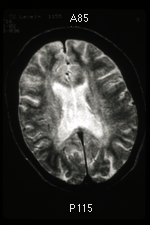
The scan shows diffuse, severe changes in cerebral white matter (center), which normally appears black on MRI. The fuzzy outline of the white matter suggests abnormal water retention.
MRI Scan of 28-Year-Old Chronic Solvent Abuser
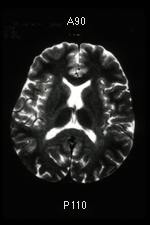
The scan shows bilateral changes in the thalamus (two dark black ovals), normally gray and white, and suggests iron deposition.
"The extensive neurological damage and cognitive impairments we found among chronic solvent abusers in our study could limit their ability to control their behavior and perceive problems associated with their substance abuse," says Dr. Neil Rosenberg of the University of Colorado Health Sciences Center in Denver, who led the study. "As a result, a comprehensive approach that integrates neurological rehabilitation with drug abuse treatment may be needed to treat them successfully."
The study sought to clarify the type and extent of brain damage and neuropsychiatric impairment induced by chronic abuse of inhalants and cocaine. Researchers compared brain images and results of cognitive tests obtained from a large group of chronic, long-term solvent abusers with those of a comparable group of chronic cocaine abusers. Such information can be useful in developing appropriate treatment responses for both populations.
Fifty-five inhalant abusers completed a battery of cognitive tests, and 50 of them also underwent brain magnetic resonance imaging (MRI). In the comparison group, 61 cocaine abusers participated in cognitive testing, and 51 of them underwent brain MRIs.
Inhalant abusers inhaled primarily vapors from spray paint containing toluene, a commonly abused solvent found in many inexpensive household and industrial products, including correction fluids, paint thinners, and paint removers. Individuals in this group averaged more than 10 years of regular abuse of inhalants. Their patterns of abuse ranged from "sporadic and intense" through "continuously," with more than half of the group indicating they stayed high on solvents for most of every day. Participants in the comparison group had a similar history and pattern of chronically abusing other drugs, mainly cocaine and alcohol.
Both groups of drug abusers performed below general population averages on a series of tests that measured such cognitive functions as short-term memory, delayed recall, the ability to learn and make associations, and executive cognitive abilities. The low level of general intellectual functioning on most tests was similar for both groups, but inhalant abusers did significantly worse than cocaine abusers on tests involving working memory and executive cognitive functions, which include the ability to focus attention, plan, solve problems, and control one's behavior appropriately.
Inhalant and Cocaine Abusers With Subcortical Abnormalities, by Brain Region Affected
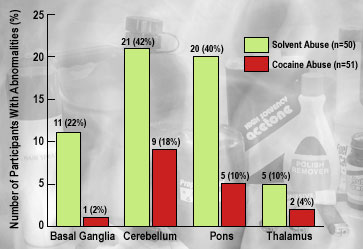
Magnetic resonance imaging scans of chronic inhalant abusers and chronic cocaine abusers showed more frequent occurrence of abnormalities in the basal ganglia, cerebellum, pons, and thalamus for those who abused solvents.
Both groups also had a high proportion of abnormal MRI scans, which reveal major changes in the structure of the brain. However, inhalant abusers were significantly more likely to have brain abnormalities than the comparison group. Almost half (44 percent) of the solvent abusers had abnormal MRIs compared to just over one-quarter (25.5 percent) of the comparison group. The relatively large numbers of inhalant abusers in the study enabled the researchers to show that the amount of past use of inhalants was related to the extent of brain abnormalities.
More solvent abusers than cocaine abusers had abnormalities in each of four brain structures the researchers examined -- the thalamus, basal ganglia, pons, and cerebellum. These structures play a critical role in receiving sensory information from the peripheral nervous system and the spinal cord and relaying messages throughout the brain that coordinate and control a variety of functions, including voluntary and involuntary movements. Common clinical consequences of pathological changes in these areas that have been reported in chronic inhalant abusers include difficulty coordinating movement, gait disorders, and spasticity, particularly in the legs. (See graph for comparison of abnormalities found in both groups in the four brain regions.)
Solvent abusers also had more extensive and more severe abnormalities in brain white matter (WM), a type of nerve tissue made up largely of specialized support cells and myelinated nerve fibers. Myelin is a white, fatty, insulating sheath that speeds up the transmission of nerve signals to different parts of the brain, including those involved in cognitive functions, such as language comprehension. The diffuse WM abnormalities found among solvent abusers in the study were associated with greater cognitive impairment. For example, the 12 percent of inhalant abusers who had diffuse moderate to severe WM abnormalities had a mean verbal IQ score that was nearly 20 percent lower than the already low average score registered by the rest of the group.
"Some of the brain damage and cognitive deficits seen in both primary inhalant and cocaine abusers in the study could stem from the heavy use of alcohol that was common among both groups," Dr. Rosenberg notes. "However, the diffuse white matter changes and abnormalities found in the thalamus have not been seen in alcohol abusers and are clearly from solvent abuse."
In spite of the extent of the neurologic damage and cognitive impairment the study found in chronic inhalant abusers, there is reason to be aggressive in treating them, Dr. Rosenberg says. "Every day we learn more about the ability of the central nervous system to regenerate. Our laboratory work suggests that the solvent-induced pathology that produces the primary MRI signal abnormality in the white matter results from alterations in the cellular membrane of nerve tissue. The pathology doesn't really look like it's destroying neurons or damaging their axons, the fiber-like extensions that send information to other cells. The picture suggests that if you can stop the inhalant abuse, there's a good chance you can get significant recovery of function in chronic abusers."
